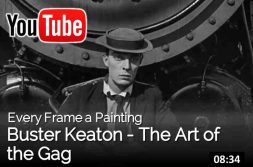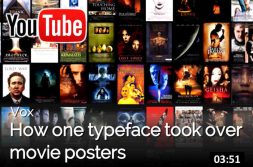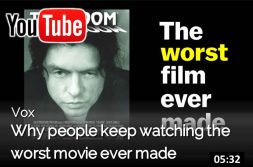Movies
Questions
1. Tell us about your favorite movie.
2. What is the name of a famous movie from your country?
3. Does your country make many movies?
4. Why are American movies so popular?
5. Do you watch more American movies or movies from your country?
6. What is your favorite action comedy movie?
7. Do you prefer old movies or modern ones? Why?
8. Which actor would play you in a movie about your life?
9. If you could make a movie, what would it be about?
Videos
Before Edgar Wright and Wes Anderson, before Chuck Jones and Jackie Chan, there was Buster Keaton, one of the founding fathers of visual comedy. And nearly 100 years after he first appeared onscreen, we’re still
[more]
learning from him. Today, I’d like to talk about the artistry (and the thinking) behind his gags.
[less]
Category: Art | Psychology
Why Hollywood kept using Trajan.
For the past 25 years, one typeface has dominated Hollywood typography: Trajan. It’s everywhere, from
For the past 25 years, one typeface has dominated Hollywood typography: Trajan. It’s everywhere, from
[more]
Shakespearean epic classics like Titus to gory modern flicks like The Human Centipede. It was even the official typeface of the Academy Awards for a while. In movie poster design, if you want to make a film look official, you use Trajan. So how did that happen? Designer Yves Peters set out to answer that question.
[less]
Category: Art
Some filmmakers can do action. Others can do comedy. But for 40 years, the master of combining them has been Jackie Chan. Let’s see how he does it. (Note: to see the names of the films, press the CC button!)
Category: Art
Many people consider The Room to be the worst movie of all time. So why do thousands of people flock to midnight screenings of it every month?
Tommy Wiseau’s film The Room (2003) is by many accounts the worst movie ever made. The plot barely makes sense, the set design is comically inept, and most of the dialogue sounds like it was fed through Google Translate multiple times. Yet, for 14 years, people have been congregating at midnight screenings all across the globe to watch what some people call “the Citizen Kane of bad movies.”
Despite the film’s incoherency, audiences ritualistically throw plastic spoons, shout call and response lines at the screen, and toss around footballs in the aisles at monthly screenings. Knowing all the inside jokes and participatory cues gives viewers what sociologist Pierre Bourdieu termed “cultural capital.” People who know when to shout specific lines or when to hurl spoons are deemed Room veterans.
Contrary to what you may think, researchers have found that an appreciation of this kind of “trash cinema” can actually indicate higher levels of intelligence. Trash films share more characteristics with avant-garde art films than they do with typical commercial Hollywood fare. Audiences are drawn to both “trash” and “art” films for many of the same reasons, like their transgressive nature and their rejection of mainstream aesthetic norms.
Watch the video to know more about The Room and be sure to pick up Bissell’s book (that he co-wrote with Greg Sestero) to read many more legendary stories about the production of the “best worst movie.”
[more]
Tommy Wiseau’s film The Room (2003) is by many accounts the worst movie ever made. The plot barely makes sense, the set design is comically inept, and most of the dialogue sounds like it was fed through Google Translate multiple times. Yet, for 14 years, people have been congregating at midnight screenings all across the globe to watch what some people call “the Citizen Kane of bad movies.”
Despite the film’s incoherency, audiences ritualistically throw plastic spoons, shout call and response lines at the screen, and toss around footballs in the aisles at monthly screenings. Knowing all the inside jokes and participatory cues gives viewers what sociologist Pierre Bourdieu termed “cultural capital.” People who know when to shout specific lines or when to hurl spoons are deemed Room veterans.
Contrary to what you may think, researchers have found that an appreciation of this kind of “trash cinema” can actually indicate higher levels of intelligence. Trash films share more characteristics with avant-garde art films than they do with typical commercial Hollywood fare. Audiences are drawn to both “trash” and “art” films for many of the same reasons, like their transgressive nature and their rejection of mainstream aesthetic norms.
Watch the video to know more about The Room and be sure to pick up Bissell’s book (that he co-wrote with Greg Sestero) to read many more legendary stories about the production of the “best worst movie.”
[less]
Category: Art | Psychology



